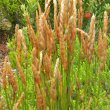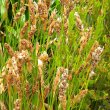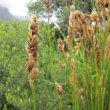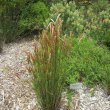Elegia fistulosa
| Botanical Name | Elegia fistulosa |
|||||||||||
| Family | Restionaceae - The Cape reed family. |
|||||||||||
| Pronunciation | el-EE-jee-a fist-yoo-LOW-suh |
|||||||||||
| Common Name(s) |
English: Hollow Reed
Afrikaans: Pypriet
|
|||||||||||
| Plant Group |
|
|||||||||||
| Plant Size |
|
|||||||||||
| Position |
|
|||||||||||
| General Information |
|
|||||||||||
| Specific Information | Elegia fistulosa is easy to grow, is pest free needs little maintenance. It is neat, tufted and upright, with hollow, slender reed-like stems up to 1 meter tall. It forms a medium sized tussock with a flower head on every stem, on both male and female plants. After flowering in spring, the attractive golden brown bracts remain on the plants for most of the year. The stems grow to maturity and flower during their second year and die off during the third year. The old stems are constantly renewed from the center. Elegia fistulosa will not survive freezing weather but should survive a light frost. Elegia fistulosa does not do well in high traffic areas as the stems are prone to flopping if knocked about. |
|||||||||||
| Ad Break | ||||||||||||
| Flowers | ||||||||||||
| Description | flower insignificant and almost hidden by the golden brown bracts |
|||||||||||
| Season |
|
|||||||||||
| Colour |
|
|||||||||||
| Growth Rate |
|
|||||||||||
| Plant Uses |
|
|||||||||||
| Distribution and Habitat | widespread from Malmesbury in the Western Cape to Port Elizabeth in the Eastern Cape, along the coastal plateaux and mountain ranges, in damp places, or with their roots in running water |
|||||||||||
| Planting Suggestions | Plant in full sun, in very well drained soil, with free air-circulation. Avoid planting near a hot wall. Feed with slow release, high nitrogen organic or chemical fertilizer and water regularly. If grown in hot, dry areas they must be watered several times a week. |
|||||||||||
| Medicinal Uses | No data found. |
|||||||||||
| Ad Break | ||||||||||||








Discuss this plant
Share knowledge, ask a question or give an experience.